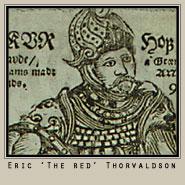 Like many details of Viking history, the settlement of Iceland
is clouded in mystery. Vikings did not record their exploits.
However tales written in the 12th or 13th centuries, called
Sagas, purport to tell of the founding of this far-northern
island. According to these stories, many details of which have
been confirmed by archeologists, Vikings discovered Iceland
in the late 9th when a ship sailing from Norway to the Faro
Islands was blown off course. Legend has it that the island
had previously been inhabited intermittently by Irish monks.
Like many details of Viking history, the settlement of Iceland
is clouded in mystery. Vikings did not record their exploits.
However tales written in the 12th or 13th centuries, called
Sagas, purport to tell of the founding of this far-northern
island. According to these stories, many details of which have
been confirmed by archeologists, Vikings discovered Iceland
in the late 9th when a ship sailing from Norway to the Faro
Islands was blown off course. Legend has it that the island
had previously been inhabited intermittently by Irish monks.
Researchers say the history of the Viking colonization of
Iceland could answer many questions about the impact of humans
on nature. In most places, human occupation goes back thousands
or tens of thousands of years, making it hard to study what
role, if any, people had in changes in the flora and fauna.
But in Iceland, scientists know almost precisely when settlers
arrived, just over 1,000 years ago. Barring evidence to the
contrary, they assume that any changes in wildlife since then
has been caused by human activities.
For the last decade, archeologists in Iceland have been studying
a cluster of abandoned Viking settlements near Lake Myvatn,
on the island's north side. Carbon 14 dating of specimens
from the digs and other evidence suggest these sites were
some of the earliest farms in Iceland. The research shows
that the impact of Vikings settlers on the wildlife of Iceland
was swift and massive. For instance, chunks of charcoal and
impressions in the soil of large roots suggest to the researchers
that when these people arrived, the land was densely wooded.
However within a generation the trees were gone, and irreversible
soil erosion had set in.
|











